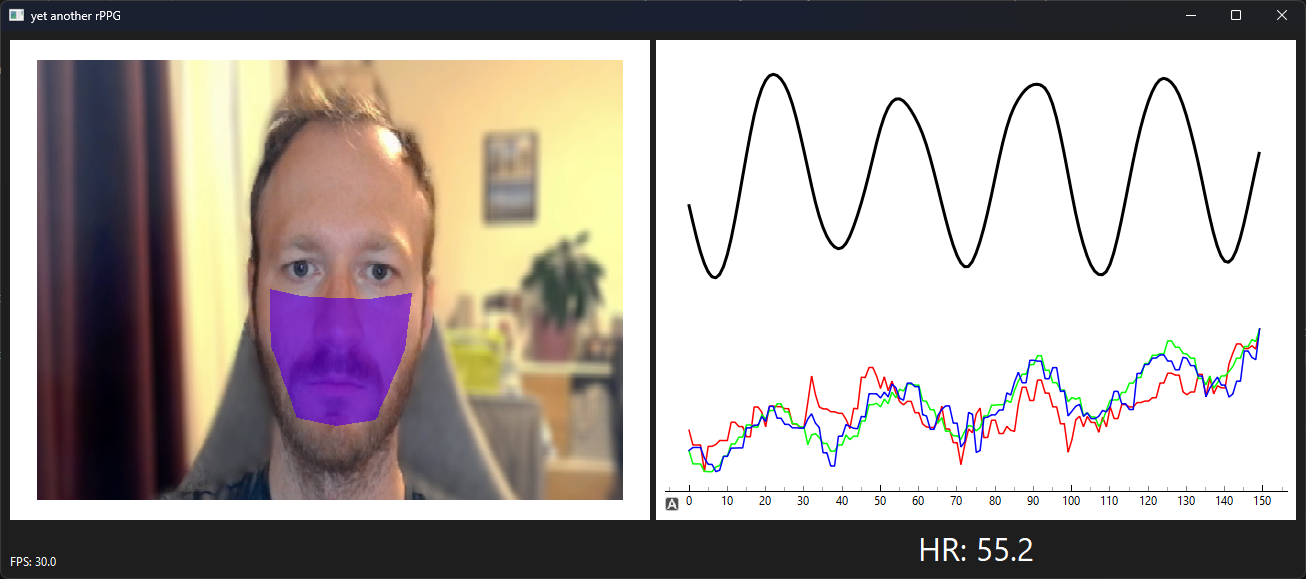yarppg is yet another implementation of remote photoplethysmography in Python. Remote photoplethysmography (rPPG) refers to the camera-based measurement of a (blood volume) pulse signal. It works by detecting small changes in skin color, originating from the pulsation of blood [1].
Some other open-source implementations of rPPG:
- heartbeat: Live heart rate measurements. Written in C++ with a number of customization options (https://github.com/prouast/heartbeat)
- Bob's implementation of different rPPG algorithms: Python implementation of different publications for offline evaluation. (https://www.idiap.ch/software/bob/docs/bob/bob.rppg.base/master/)
The current default implementation uses the bandpass-filtered green channel averaged across a custom ROI suggested by Li et al. [2] Other features of their algorithm are a work in progress.
In order to run this rPPG implementation, you first have to clone the
repository and make sure all requirements are installed. Afterwards you
can run the yarppg subfolder as a python package using the -m flag:
git clone https://github.com/SamProell/yarppg.git
cd yarppg
pip install -r requirements.txt
python -m yarppg # from yarppg top-level directoryAlternatively, install the package using pip (from the top-level directory).
After installing, you can simply call the provided entry point run-yarppg.
pip install -e .
run-yarppgThere are a number of options available, when running yarppg:
| Option | Default | Description |
|---|---|---|
| --detector | facemesh | ROI (face) detector - choices: {facemesh,caffe-dnn,haar,full} |
| --processor | LiCvpr | Processor translating ROI to pulse signal. LiCvpr currently only returns mean green value - choices: {LiCvpr,Pos,Chrom} |
| --winsize | 32 | Window sized used in some processors (in frames) |
| --bandpass | 0.5,2 | bandpass frequencies for processor output |
| --blobsize | 150 | quadratic blob size of DNN Face Detector |
| --draw-facemark | False | draw landmarks when using facemesh detector |
| --blur | -1 | pixelation size of detected ROI |
| --video | 0 | video input device number or filename |
| --limitfps | None | force a delay when reading frames (specified in milliseconds) |
| --savepath | '' | store generated signals as data frame to disk |
For rPPG to work as intended it might be required to tweak the camera
settings. For example auto white-balancing and auto-exposure could be
disabled, to avoid small adjustments in RGB values.
One possibility to change the camera settings is via the ffmpeg
commandline tool. See the discussion here:
https://superuser.com/questions/1287366/open-webcam-settings-dialog-in-windows/1511657
| [1] | W Verkruysse, L O Svaasand and J S Nelson. Remote plethysmographic imaging using ambient light. Optics Express. 2008;16(26):21434–21445. doi:10.1364/oe.16.021434 |
| [2] | Li, X., Chen, J., Zhao, G., & Pietikainen, M. (2014). Remote Heart Rate Measurement From Face Videos Under Realistic Situations. Proceedings of the IEEE Conference on Computer Vision and Pattern Recognition (CVPR), 4264-4271. |
